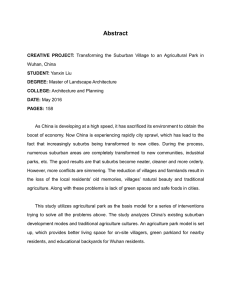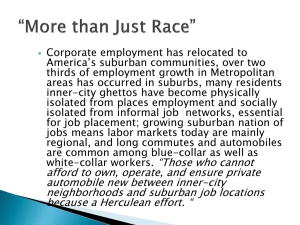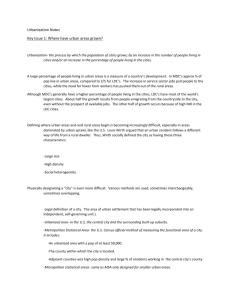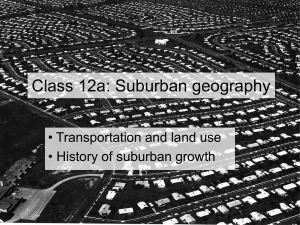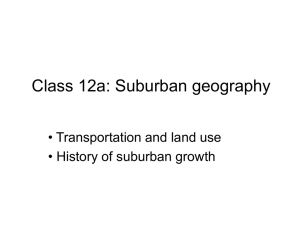Trends related to Urbanization
advertisement
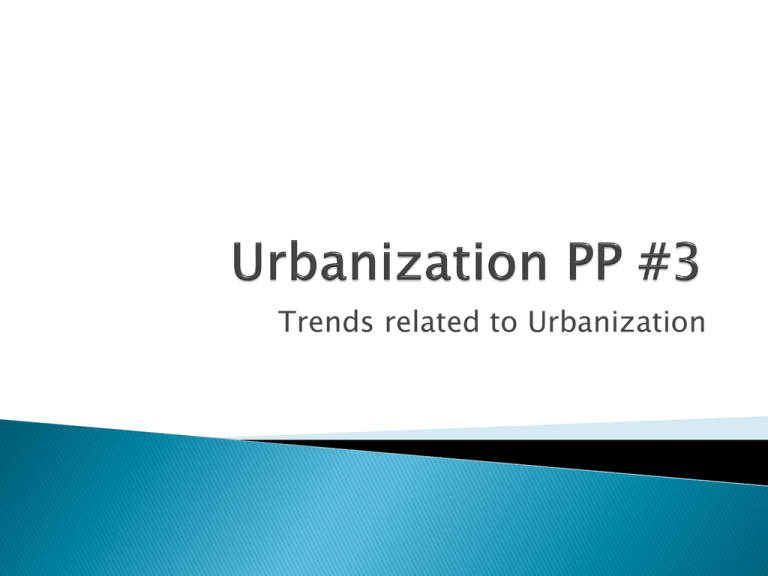
Trends related to Urbanization Most of the land in urban settlements is devoted to housing, where people live within U.S. urban areas ◦ the most fundamental spatial distinction is between innercity residential neighborhoods that surround the CBD and suburban residential neighborhoods on the periphery Inner cities in the U,S, contain concentrations of low-income people Inner-city Issues ◦ Physical ◦ Social ◦ Economic Major physical problem face by inner-city neighborhoods is the poor condition of the housing ◦ Most built before 1940 Process of Deterioration As the # of low-income residents increase in the city, the territory they occupy expands Filtering ◦ Large houses built by wealthy families in the 19th century are subdivided into smaller dwellings for low-income families ◦ Definition: Process of subdivision of houses and occupancy by successive waves of lower-income people ◦ As rent decreases, so does maintenance Eventually no one will rent, buildings abandoned Leads to schools, shops closing as well Redlining ◦ Definition: Drawing lines on a map to identify areas in which they will refuse to loan money (done by banks) ◦ As a result, families that try to fix up houses in “bad” neighborhoods have difficulty loaning money ◦ Technically illegal but difficult to enforce Underclass ◦ Inner-city residents often referred to as a permanent underclass because they are trapped in an unending cycle of economic and social problems ◦ Suffers from: High rates of unemployment, alcoholism, drug addiction, illiteracy, juvenile delinquency, and crime ◦ Schools, hospitals, shops are all deteriorated Lack adequate fire/police protection ◦ Homeless Estimated that nearly 1 million are homeless in America ◦ Future is bleak Little to no technical skills Fewer than ½ complete high school Atmosphere ignores “good habits” With less Primary and Secondary jobs, even more unemployment Culture of Poverty ◦ Trapped in cycle because they live in a culture of poverty 3/4ths of babies in inner-cities born to unwed mothers 3/4ths of children live with 1 parent Many mothers have to stay home “Deadbeat Dads” no help ◦ Many turn to drugs Rates of use have most rapidly increased in inner-cities recently Many obtain through criminal activities Leads to gangs controlling drug distribution Contributes to gang violence ◦ Many neighborhoods segregated Most inner-city residents are African-American and Hispanic Eroding Tax Base ◦ Low-income inner-city residents require more public services But can pay very little of taxes necessary to support those services ◦ Central cities face growing gap between need of services and funds to pay for them Impact of Recession ◦ Once of the principal causes of severe recession in 2008 was collapse of housing market Two choices: Reduce Services Close libraries, eliminate bus routes, collect trash less frequently Raise Tax Revenues Provide tax breaks for downtown offices, luxury hotels, restaurants, shops Even with break, still pay more taxes than abandoned buildings ◦ Federal Aid to cities has significantly decreased since 1980s Declined 2/3rds Primarily in the inner city Banks had increased loans to lowincome inner-city households buying their 1st home Many had poor credit, no background checks Called subprime mortgages ◦ Investing in housing viewed as way to get higher rate of return than other investments House prices increased rapidly Banks saw this as an opportunity to increase # of home owners ◦ Concentric model shows inner- city residents more likely to be renters ◦ When people can’t repay loans= bank foreclosure In 1st year of recession 10% of Americans behind on their mortgages ◦ Compounding problem- the housing bubble burst Homes have decreased in value Home now worth less than mortgage Ghettoization ◦ Definition: Refers to the growth of areas of concentrated poverty ◦ Originally comprised of mostly immigrants Newly-arrived Irish, Italian, and German immigrants But even larger AfricanAmerican and Hispanic ghettos have grown since the 1950s Real Estate developers and banks contributed to growth of urban ghettos in 3 ways: ◦ Blockbusting When real estate agents and developers used racism to “bust up” a block by bringing in a minority family into a predominately white neighborhood Then profited in all the turnover ◦ Racial Steering When real estate agents would intentionally or unintentionally steer people to buy a home in a neighborhood based on their race, which contributed to racially segregated housing patterns ◦ Redlining Banks refusing loans in central neighborhoods that were “redlined” Urban Renewal Cities identify blighted inner-city neighborhoods They acquire property, move residents, demolish, and rebuild National government grants help finance Has been criticized for destroyed older neighborhoods and reducing supply of low-cost housing Called “Negro Removal” in 1960s Many North American and European Cities have turned away from ◦ Public housing Many sub-standard inner-city houses have been demolished and replaced with public housing In U.S. public housing is reserved for low-income households Must pay 30% of their income for rent Maintained by housing authority Only 1% of all dwellings U.S. has stopped funding most public housing Instead looks to renovating old buildings from 1950s and 1960s ◦ Renovated housing Some non-profit organizations renovate lowincome housing and sell or rent to low-income people Example: Habitat for Humanity Definition: ◦ Process by which middle-class people move into deteriorated inner-city neighborhoods and renovate housing ◦ Chicago Why? ◦ ◦ ◦ ◦ ◦ ◦ Houses may be larger More substantially constructed Cheaper than suburbs Architectural details Close to work No children In cities where there is strong gentrification, ethnic patterns are being altered Inner-city white population increasing African-Americans, Hispanics declining Renovations are expensive! ◦ Cities encourage with low-cost loans and tax breaks ◦ Encourages middle-class to move in, low-class to move out Not concerned with inner city schools U.S. and other countries have laws to protect low-class families Moving farther from center Reimbursed for moving and rent increases over 4-year period Some argue helps disperse lower-income families more evenly throughout city ◦ Instead of clumping in one area Annexation ◦ Definition: ◦ Definition: ◦ Rules concerning annexation vary from state to state ◦ In the U.S. a city surrounded by suburbs is sometimes called a central city ◦ Boundaries of a city define the geographic area within which the local government has legal authority Defines an urban settlement that has been legally incorporated into an independent, self-governing unit Process of legally adding land area to a city Usually only happens when majority of residents in the area vote in favor of doing so The city Often desired in 19th century because cities offered more services Today it is less likely, most don’t want to pay city taxes Defining Urban Settlements ◦ City: a legal entity ◦ Urbanized Area: a continuously built up area ◦ MSA: a functional area Urbanized Area ◦ Definition: In the U.S. the central city AND surrounding suburbs Approximately 70% of U.S. population lives in urbanized areas MSAs ◦ Functional area Minimum of 50,000 people Surrounding counties with high population density and large % of residents working in the central city Also have micropolitan statistical areas Definition: ◦ The increase in rural populations that result from the out-migration of city residents from their city and suburban homes in search of nonurban lifestyles Exburbs ◦ Noticed in the 1950s ◦ Rings of wealthier communities that grew just outside of the suburbs Telecommuting ◦ Modern form of commuting that involves only commuting of information, not the worker Developed by Chauncy Harris According to model, an urban area consists of an inner city surrounded by large suburban and residential areas tied together by a beltway or ring road Edge Cities ◦ Definition: Around the beltway are nodes of consumer and business services ◦ Originally built as suburban residences Services grew with population Many are specialized nodes Collection of hotels around airports, etc. Density Gradient ◦ As you travel outward from the center city, the population density declines According to the density gradient, the # of houses per unit of land diminishes as distance from the center city increases Urban Sprawl: ◦ Diffusion of urban land use and life-style into formerly nonurban, often agricultural lands Uneven Development ◦ Definition: Refers to urban development that is not spread equally among a city’s areas Leaves some areas richly developed and others continually poor and decrepit ◦ Often caused by cumulative causation When money flows to areas of greatest profit As suburban regions grew and became more desirable two consequences occurred ◦ Segregated social classes ◦ Segregated land uses Residential Segregation ◦ Prior to suburbs, vertical integration in cities ◦ Once cities spread out replaced by territorial segregation ◦ Suburban neighborhoods discouraged entry of lowincome or minority residents Feared loss of property values Segregated Land Uses ◦ Zoning ordinances were developed in European and North American Cities in the early decades of 20th century Prevented to mixing of landuses within the same district Businesses have moved to the suburbs too Suburbanization of Retailing ◦ Most residents no longer want to make journey to CBD ◦ Retailing has increased in planned suburban shopping malls ◦ Manufacturers have selected peripheral locations because land costs are lower ◦ Services have moved to be closer to customers Malls have become centers for activities in suburban areas Suburbanization of Factories and Offices ◦ Factories and warehouses have migrated to suburbia for more space, cheaper land, and better truck access ◦ Offices that do not require faceto-face contact are increasingly moving to the suburbs Historically, growth of suburbs was constrained by poor transportation Motor Vehicles ◦ Suburban explosion of 20th century relied on motor vehicles Rather than railroads of 19th century rail-lines restricted development to narrow ribbons within walking distance of stations ◦ People lived in crowded cities because they had to be within walking distance of shops and employment ◦ Cars/trucks permitted large-scale development from the center Invention of railroad 1st allowed people to live in suburbs but work in the central city Later improved to streetcars/trolleys, then subways to accommodate commuters Provided more flexibility ◦ Ownership nearly universal in American households Public Transit ◦ Few people now live within walking distance of employment Urban areas are characterized by extensive commuting European cities like London, England have worked to limit urban development to a particular area by installing a green belt ◦ A boundary that forces all urban development to occur within the city’s urban core North American cities have a difficult time setting such boundaries ◦ Can attract investors who want to develop lands and grow the city at the expense of rural lands Portland, Oregon ◦ One U.S. city that has effectively instituted a boundary to contain urban sprawl Boundary forced revitalization of the inner-city, not outward growth While it did work, it also increased cost of living and real estate prices substantially Definition: One neo-urban trend is planned communities ◦ Movement to bring together trends in healthy living, sustainable growth, and urban development ◦ Neighborhoods with masterplanned housing designs, walkable pathways, recreational facilities, and security features Many recent, neo-urban designs include festival settings ◦ Large recreational areas for communities, such as waterfront parks along rivers
